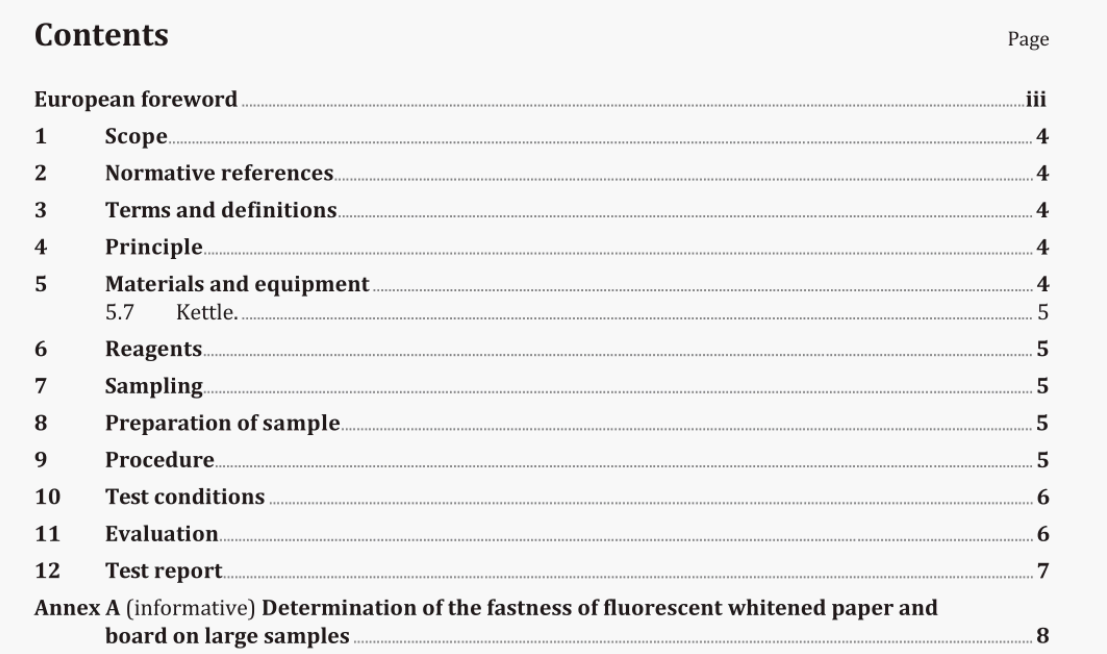BS EN 646:2018 pdf download.Paper and board intended to come into contact with foodstuffs – Determination of colour fastness of dyed paper and board
1 Scope
This document describes procedures for the testing of dyed paper and board intended to come into contact with foodstuffs. Some procedures depending on the foreseeable use of the material are given.Visual evaluation against a grey scale provides grading of the bleeding.For samples having significant different sides, a migration can occur from one glass fibre to the other and could lead to wrong interpretation of the fastness of one side. It is advisable to check these samples using large sampling procedure to prevent cross contamination of the glass fibre during the migration procedure. The procedure is described in Annex A. If lower limit of detection is required, this procedure could also be used.
2 Normative references
The following documents are referred to in the text in such a way that some or all of their content constitutes requirements of this document. For dated references, only the edition cited applies. For undated references, the latest edition of the referenced document (including any amendments) applies.
EN 20105-A03, Textiles – Tests for colour fastness – Part A03: Grey scale for assessing staining (ISO 105-A03)
EN ISO 186, Paper and board – Sampling to determine average quality (ISO 186)
EN ISO 3696, Water for analytical laboratory use – Specification and test methods (ISO 3696)
ISO 6588-2, Paper, board and pulps – Determination of pH of aqueous extracts – Part 2: Hot extraction
3 Terms and definitions
For the purposes of this document, the following term and definition applies.
ISO and IEC maintain terminological databases for use in standardization at the following addresses:
IEC Electropedia: available at http://www.electropedia.org/
ISO Online browsing platform: available at http:/ /www.iso.org/obp
9.2 Immerse two sheets of unstained glass fibre papers (5.1) in a test fluid (6.1, 6.2, 6.3 or 6.4). Remove the sheets after saturation and free the sheets from excess fluid by wiping on the rim of the container.
9.3 Place one sheet of unstained glass fibre paper with its smooth side upwards on the glass plate (5.2]. Place the test piece (Clause 8) immediately on the unstained glass fibre paper. Cover it with the second saturated sheet of unstained glass fibre paper, so that the smooth side of the unstained glass fibre paper is in contact with the test piece again. Place a second glass plate (5.2) on top of the second unstained glass fibre paper and for procedures A and B wrap the total assembly in polyethylene film (5.3) to prevent the edges from drying out, load it with a mass of 1 kg (5.4) and allow it to stand under the condition of Table 2 with protection against direct light penetration.
9.4 If test pieces of a grammage of> 140 g/m2 are to be investigated, an appropriate even number of unstained glass fibre paper layers (5.1) is used so that the total of their grammages just exceeds the grammage of the test piece.
9.5 After the storage time open the assembly. Place the unstained glass fibre papers on 3 adjacent glass rods, 0 8 mm to 0 10 mm, with the side which was in contact with the test piece upwards, cover them without contact to prevent light penetration and air-dry at ambient temperature. Unstained glass fibre papers saturated with olive oil are not dried.
BS EN 646:2018 pdf download
